Your source for the latest news on yachts, boats and more. Read through our articles to find out how to compare boats and find the right fit for you!

Power Catamarans: A Complete Guide
Dec 06, 2023
less than a min
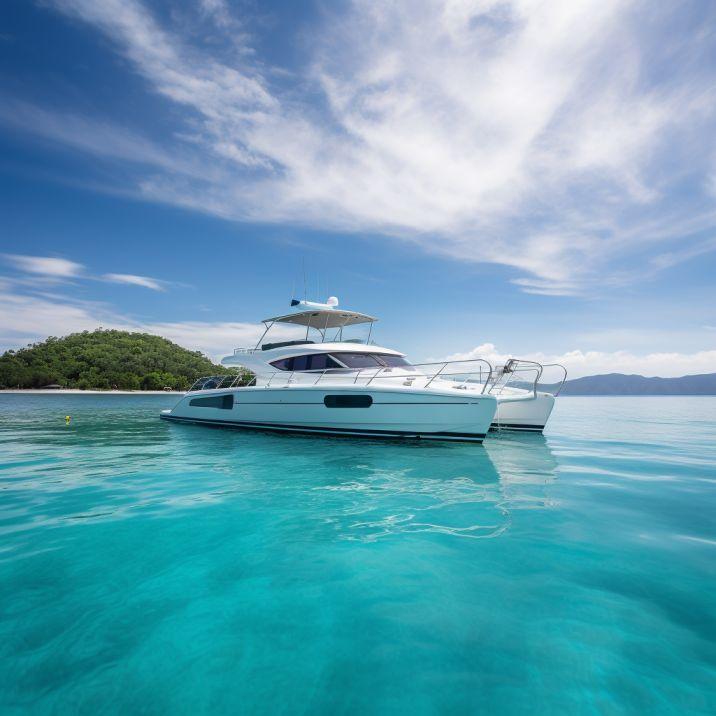
Power Catamarans, often termed as the epitome of modern maritime engineering, are gaining popularity for all the right reasons. Their distinct design, enhanced stability, and cruising efficiency set them apart from traditional monohull boats and even their sail-driven counterparts. This guide dives into the world of Power Catamarans, shedding light on their advantages and how they compare to other vessels like monohulls and trimarans.
Historical Prelude:
The concept of catamarans traces its roots back to ancient maritime cultures. However, the power catamaran is a relatively modern innovation that marries the traditional twin-hull design with powerful engines, offering a unique blend of speed, stability, and space.
Distinguishing Design:
Power Catamarans are characterized by their twin hulls, which significantly reduce the drag, thus enhancing speed and fuel efficiency. Unlike monohulls, they have a broader beam, which contributes to increased stability and more living space. The absence of a ballast for stability further lightens the vessel, contributing to its speed and fuel economy
Speed and Handling:
One of the significant advantages of power catamarans is their speed and handling. The twin hulls allow for a smoother glide over the water, making them particularly favorable for watersports enthusiasts. Their handling in rough waters is superior to monohulls, thanks to the inherent stability provided by the dual-hull design.
The stability of power catamarans is unparalleled, especially when compared to monohulls. The wide beam and twin hulls provide a stable platform, reducing the rocking and rolling common in monohulls. This stability is not only comforting in rough seas but also crucial when docking or anchoring.
Comfort and Space:
The spacious design of power catamarans offers homelike livability, with ample room for cabins, lounges, and even onboard amenities like grills and bars. The wide beam also allows for large deck spaces, ideal for sunbathing or enjoying the scenic ocean vistas.
Economy and Redundancy:
Power catamarans are economical, with fuel efficiency being one of their selling points. The redundancy built into their design, with separate engines for each hull, provides an added layer of safety, ensuring that the vessel can return to shore even if one engine fails.
Regular Upkeep and Care:
Power catamarans, given their unique design and structure, come with their own set of maintenance requirements. Like all boats, routine checks and upkeep are essential to ensure smooth sailing. The twin hull design means double the underwater gear – from propellers to rudders, which necessitates regular inspections for any signs of wear, tear, or fouling.
Antifouling:
Given that power catamarans have a larger surface area underwater due to their twin hulls, they may be more susceptible to marine growth. Regular antifouling treatments can help in keeping the hulls clean, ensuring optimal performance and fuel efficiency.
Engine Maintenance:
One distinct advantage of power catamarans is their dual-engine setup, but this also means double the engine maintenance. Regular oil changes, cooling system checks, and filter replacements are crucial. It's beneficial to synchronize maintenance schedules for both engines to ensure consistent performance.
The lifespan of a power catamaran largely depends on its build quality, materials used, and how well it's maintained. With proper care, a power catamaran can last for several decades. The engine's maintenance significantly impacts the catamaran's lifespan, with gasoline engines requiring maintenance at 1,200 to 1,800 hours and diesel engines at around 5,000 hours. The construction materials play a crucial role; for instance, fiberglass catamarans, when well-maintained, can last for many decades, while aluminum cats might change ownership after 10-15 years but can last a lifetime with proper care.
World-Renowned Builders:
The power catamaran sector boasts several reputable manufacturers such as Lagoon, Leopard Catamarans, Fountaine Pajot, and other notable names like Seawind Catamarans.
Lagoon, a revered name under the Beneteau Group umbrella, has carved its niche in crafting luxurious, spacious catamarans. A prime example is the Lagoon 630 Motor Yacht, embodying opulence with its nearly 250 sq. ft. aft deck and 900 sq. ft. interior, comfortably housing up to 12 guests. Known for its superyacht styling, it boasts superior fuel efficiency and a commendable average velocity-made-good of 9 knots.
Leopard Catamarans:
Emerging from the reputable Robertson and Caine shipyard in South Africa, Leopard Catamarans is synonymous with innovation and efficiency. The Leopard 53 Powercat is a testament to this legacy, showcasing excellent seakeeping abilities, offering 3 or 4 cabin configurations, and achieving a top speed of 25 knots.
Fountaine Pajot:
A trailblazer since 1976, Fountaine Pajot constantly redefines catamaran design. The Fountaine Pajot MY6 is a shining example, encapsulating the brand's visionary ethos. Stretching 15 meters, the MY6, equipped with dual engines of up to 2 x 353 Kw and 2 x 480 hp, promises dynamic sailing. Crafted meticulously by Pier Angelo Andreani, the interior mirrors a 20-meter monohull's spaciousness, reflecting modern aesthetics and comfort that stand as a benchmark in the Motor Yacht world.
These manufacturers continue to innovate, offering a blend of luxury, performance, and efficiency in their power catamaran models, making them a popular choice among maritime enthusiasts.
Comparing with Monohulls and Trimarans:
While monohulls are traditional and often cheaper, they lack the stability and space offered by power catamarans. On the other hand, trimarans, with three hulls, provide even more stability but at the cost of additional drag and less interior space.
TheBoatDB - Your Gateway to Maritime Exploration:
If you’re looking to delve deeper into the world of power catamarans and other vessels, TheBoatDB offers a comprehensive boat database. Explore various catamaran models, compare them with monohulls, trimarans, and other types of boats, and make an informed decision on your next maritime adventure.
In summary, power catamarans encapsulate a modern engineering marvel in the maritime domain. Their blend of speed, stability, comfort, and economy makes them an attractive option for a broad spectrum of boaters. Whether you are a long-distance cruiser, a water sport enthusiast, or someone who cherishes the tranquility of the sea, a power catamaran could be the vessel that transforms your maritime adventures into unforgettable experiences.
You might like these too

Sailboat or Motorboat – Learn the pros and cons lg ...
Aug 24, 2022

Types of Catamaran Boats: Sailing, Power, and Luxury Catamarans lg ...
Feb 10, 2023

Which is better a wooden boat or fiberglass boat lg ...

What are the main types of sail rigs for sailboats lg ...

Which is the Best Economical Catamaran lg ...
Oct 04, 2021

What is a Chine on a Boat lg ...
Oct 01, 2021
| Ed Horstman designed TRIMARAN and CATAMARAN plans are drawn for the first time builder. Plans are concise and clearly drawn so the builder can easily follow each building step. Designs are continuously updated with your input and new ideas. Plans include full size patterns to 63'. The larger TRI's and CAT's have full radius hulls.With no lofting you build right away. The DESIGNER'S book TRIMARAN and CATAMARAN CONSTRUCTION is part of the plans (over 21') and covers all phases of construction. Plans are leased to build ONE boat, NO time limit. Tri-Star designs are proven designs, sailing the seven seas since 1964. Free consultation is provided to the original non-professional builder till he or she is sailing the seven seas. All boats may be built with flared hulls, with the exception of the TRI 25, TRI 26MT, CAT 27PC and the CAT 27. A DESIGN FEE for customer modifications to stock plans. Small, Fast Catamaran Design
TRI-STAR CAT 14 Plans $ Slightly Larger, Fast Catamaran Design TRI-STAR CAT 19 Plans $ Trailerable, Fast Catamaran Design with berthing areas TRI-STAR CAT 27 PC Study Plans $ TRI-STAR CAT 27 Study Plans $
TRI-STAR CAT 34 Plans $ CAT 36 designed as a spacious, fast enjoyable sailing cataramarn with accomodations found only on much larger yachts.
TRI-STAR CAT 36 Study Plans $
TRI-STAR CAT 38 Study Plans $
TRI-STAR CAT 41 Study Plans $
TRI-STAR CAT 51 Study Plans $ TRI-STAR CAT 55 Study Plans $ TRI-STAR CAT 55 Plans $ | ||||||||

Your shopping cart is empty!
Power Catamaran 46 Boat Plan
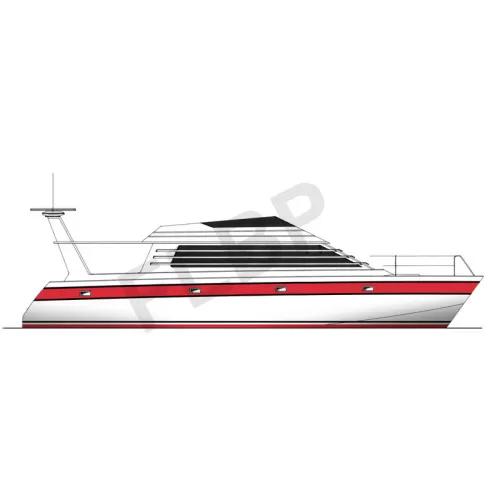
- Description
- Reviews (0)
Roberts Power Catamaran 46
These catamarans, the Cat 39 and Cat 46, were designed to be built using the fibreglass panel construction techniques. The method is very simple to use and very good for the inexperienced builder. Full size patterns are supplied for the female frame formers saving you lofting time and expertise. Special pre-scaled drawings are supplied for each hull panel making it simple for the builder to laminate all of the hull and superstructure on a flat table. The panels are set inside the pre-erected framework and laminated together similar to the plywood 'Stitch and Glue' method.
The study plan package has details of construction techniques and includes a materials list, large scale drawings of the accommodation and general arrangement. material list and more.
| LOA | 14.30 m | 48' 8" |
| LWL | 13.10 m | 43' 2" |
| DRAFT | 1.07 m | 3' 6" |
| BEAM | 7.25 m | 23' 6" |
| POWER | 150 TO 200 hp | |
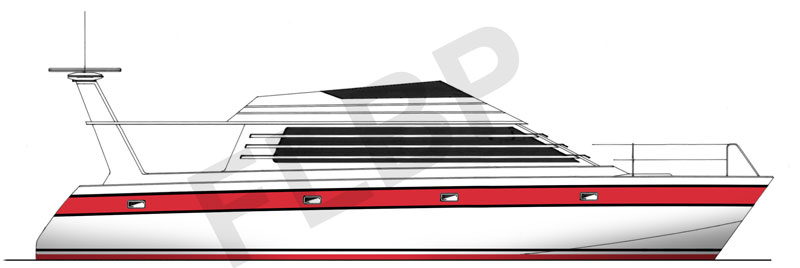
Write a review
- Brand: Bruce Roberts Designs
- Product Code: Power Cat 46
- Availability: In Stock
Prices in Australian Dollars (AUD) SP - Study Plans FPP - Full Plan and Patterns
0 reviews / Write a review
Related Products
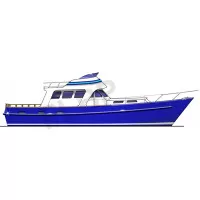
Waverunner 45 Boat Plan
Roberts Waverunner 45 This semi-displacement cruiser can be built as a Charter fishing boat, Fami..
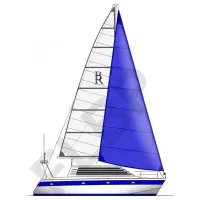
Power Catamaran 39 Boat Plan
Roberts Power Catamaran 39 These catamarans were designed to be built using the fibreglass panel ..

PCF 36-40 (Pacific Coast Fisherman) Boat Plan
Roberts PCF 36-40 (Pacific Coast Fisherman) This design may be built as a motor sailer for family..
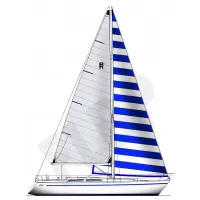
Roberts 434 Boat Plan
Roberts 434 This design has appealed to many serious cruising sailors, and is another in the late..
Tags: plans , power catamaran

Builder of the 3500 PH and CC power catamaran
Getting started.
CPC formed when the opportunity came along for our team to acquire one of the best power catamaran hulls de signed to date.
Our first recreational model, the 3500 PH, will sit on a well-tried and tested design from the drawing table of Chris White. Chris started on this project in 2004 with Russell Hunt of Multihull Development, Inc. Production of, what eventually became known as the Buzzards 34 began in 2006. An accomplished multihull designer and world cruiser, Chris brought an overriding concern for offshore seakeeping, performance, and practicality. This is clearly seen in the resulting hull design.
The design priorities included a smooth, flat ride, regardless of an afternoon chop kicking up, and a closeness to nature from both a shallow draft and a planet-friendly fuel economy. The Cape Power Cat 3500 PH has a distinctly “big boat” feel yet with the wide placement of her outboards, astonishing maneuverability, that with her manageable size guarantees easy handling.
Your boat, your choice.
Our semi-custom approach allows you to make some changes to create a perfect boat for your lifestyle!.
Photo Gallery
Sign up to hear from us about specials, sales, and events.
Connect With Us
Copyright © 2020 Cape Power Cats - All Rights Reserved.
Powered by GoDaddy Website Builder

- Create New Wish List
- Description
- Materials and Notes
a 16' smooth riding power catamaran
A word about power catamarans.
The HELL CAT features a very large cockpit with plenty of room to haul diving gear, passengers, etc. As with all the cats, the optimum word is comfort with the space to spread out, and a ride that cannot be compared to any other type of boat you may have ridden in. The tough structure, proven in prototype testing, is built to take it. Using our complete Plans and Patterns will allow you to build your own HELL CAT just the way it was designed.
Click to open Materials PDF A word about Power Cats
Related Products

Hell Cat Bronze Fastening Kit

Hell Cat Fiberglass Kit

Trailer 1200/1800 Plans - PDF
|
| | | | |
| The designs where there is a YELLOW BACKGROUND are the designs for which CUTTING FILES are available. |
|
|
|
|
|
|
Boat is well up to expectations. Have experienced some heavy weather and are impressed by the stable ride especially to windward. Judy can still use the vacuum cleaner at 30 knots + She is alo impressed by her washing machine and dishwasher not to mention the deep freeze !! Large Rig but easily handled by 2 persons. |
|
|
|
|
|
LATEST NEWS FROM OTHER BUILDERS
RETURN TO HOME / INDEX PAGE

- Plans & Kits
- Plans by type
Skoota 18 Power Cat Plans PDF

- Create New Wish List
Description
Additional information.
About Woods Downloadable Plans
Click HERE to download Free Study Plans
LOA 5.6m 18ft 4in
LWL 5.4m 17ft7in
BOA 2.5m 8ft2in
Empty weight 320kgs 700lbs
Displacement to WL 700kgs 1500lbs
Draft max 350mm 14in
Outboard engine 9.9-20hp max
The Skoota 18 is a simple to build and trail power catamaran. It is based on the Chat 18 sailing catamaran but with extra buoyancy aft to take a bigger engine, up to 20hp. This gives an economic cruising speed around 9-10 knots and top speed in the low teens. The small cuddy offers protection during the day while the boom tent and long cockpit seats mean you can camp on board for a night afloat The boat is built using conventional stitch and glue plywood, build time is estimated at 300 hours. Please email me for more details and basic studypack.
Basic Materials List (approx, no allowance for waste or errors) 6mm ply 20 sheets 9mm ply 4 sheets Timber 2in x 1in 40m 3in x 1in 2m 2in x 2in 5m 1.5in x 1in 40m Beams 4in x 2in x 2.5m 5 off glass tape 150m 100mm (4in) wide Sheathing (optional) 60sqm 200g/sqm (4oz) epoxy 20kgs screws 1000 18mm (3/4in) x no6 200 25mm (1in) x no6 st steel cs paint, filler etc as required
Related Products

Skoota 20 Power Cat Plans Download

Skoota 24 Power Cat Plans Download

Mini-Cat Plans PDF

MaXi The Cat Plans PDF
18' super pelican plans pdf.

MIKE WALLER
Yacht design.

WE SPECIALIZE IN BOAT PLANS FOR AMATEUR BUILDERS
We provide stock boat plans for both monohull and multihull sailing vessels, including sailing skiffs and sharpies. Our designs mainly feature timber construction, in plywood or cedar strip plank composite construction, using the W.E.S.T. system (wood epoxy saturation technique). Our designs are intended mainly as cruising boats, although several have done well in racing. All designs are suitable for amateur boat builders.

MONOHULLS
multihulls , photos from our builders.
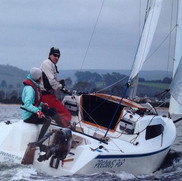

Photo galleries are provided on each design page where available
- GRAINGER DESIGNS
CRUISING NEWS

Never too young to enjoy a nice sunset.
Looloo (left) and Lucky McGee enjoying the cruising lifestyle aboard Chincogan 52 Moonraker anchored at the mouth of the estuary at the south end of Ko Phra Thong after spending a couple of weeks at Ko Phayam.

Then and now
The seafront of Cartagena in Colombia is the backdrop for two sailing vessels of different epochs and sharply contrasting character.
Against the sea wall Galeon Bucanero , a replica of a Spanish galleon of the seventeenth century is totally at home against the fortifications of this historically significant Spanish port city.
In the foreground Chincogan 52 Sole currently circumnavigating the globe stops over en route to Panama and the Society Islands.
Over the years I've received many wonderful photos of our boats from around the world. This one is an absolute classic. Many thanks to Mike and Sarah Mason for the shot.

SAILING CATAMARANS

- Scroll to top
| Design and supply of for and is Bloomfield Innovation's area of expertise. We have extensive experience in the development of composite and aluminium catamarans, including sailing and power catamaran yachts, commercial ferry catamarans and workboats. Bloomfield Innovation supply naval architect and engineering design services for composite and aluminium catamarans from 6m (20') up to 60m (200'). Our range includes trawler catamarans, power catamaran yachts and racing and cruising sailing catamaran designs. All designs may be constructed to survey or classification society rules using aluminium or composite (fibreglass, carbon fibre,…) materials. We are exclusive agents for sales of Crowther Multihulls range of sailing design covering racing and cruising designs up to 60' and have access to the entire Crowther Multihulls intellectual property base on multihull sailing design. We have close relationships with a number of multihull boat builder companies around the world or we can provide design plans and support service to your choice of boat builder. Bring your ideas to life! . |
| |
| |
| |
| |
| |
| |
| |
| |
Home | About Us | Services | Designs | News | Links | Contact Us | Site Map
Legal Disclaimer: copyright © 2004-2005 Bloomfield Innovation Pty Ltd
- THE PRINCESS PASSPORT
- Email Newsletter
- Yacht Walkthroughs
- Destinations
- Electronics
- Boating Safety
- Ultimate Boat Giveaway

The Power Catamaran Compilation
- By Yachting Staff
- Updated: December 21, 2018
Power Catamarans have been growing leaps and bounds in popularity, and, in lengths and widths. And for good reason. These cruise-centric yachts offer homelike livability for avid travelers, are fuel efficient and are fairly intuitive to run. Power cats are popular in the bareboat charter market too, for these very reasons.
Here, we take a look at 12 catamarans ranging from a cruising-couple-size 36-footer to a 78-footer for friends, family and some more friends. And there are myriad power options: outboards, diesel inboards, hybrid or even all-solar power.
Fountaine Pajot MY44
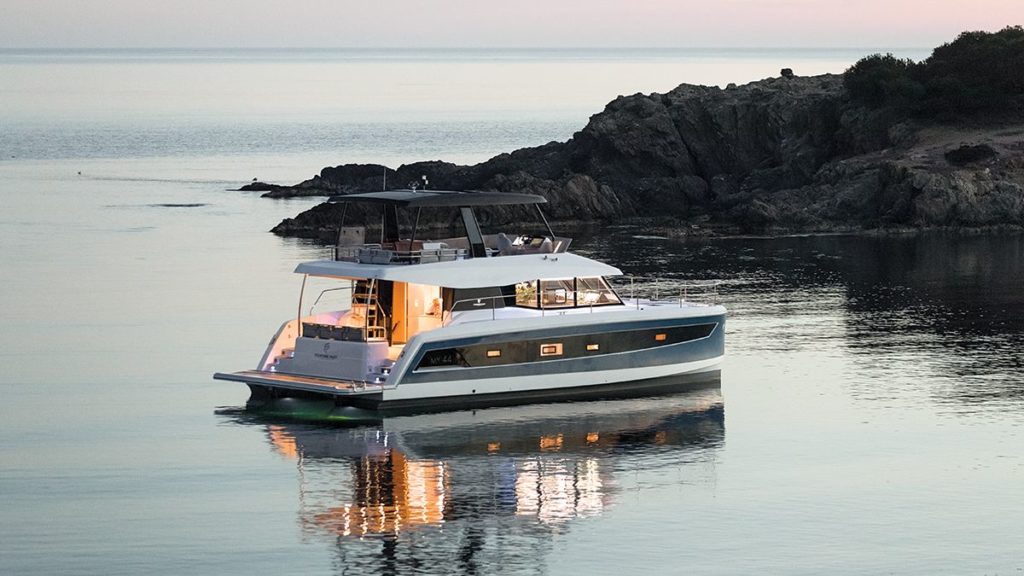
The Fountaine Pajot MY44 , a creation of Italian architect Pierangelo Andreani and French designer Daniel Andrieu, has a main deck that’s open from the aft-deck seating all the way forward to the starboard helm station. The sense of spaciousness is significant, for several reasons. First, four glass panels aft can all slide to port, creating an indoor-outdoor space with the aft deck and salon. In the salon, 32-inch-high windows extend for 12 feet down the sides of the yacht, with three sections per side, bringing in natural light along with the three forward panes that comprise the windshield. Finally, 6-foot-6-inch headroom provides vertical clearance, with a 21-foot-7-inch beam that adds interior roominess while keeping the yacht stable.
Read more: Fountaine Pajot MY44
Silent-Yachts 55
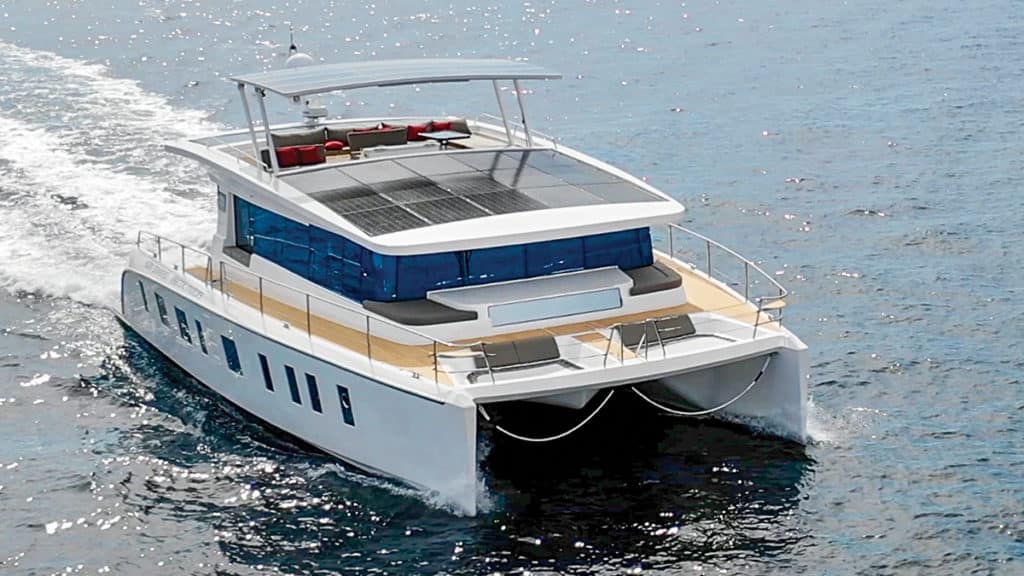
The ideas about which solar panels, electric motors, inverters and the like to use — and more importantly, Michael Köhler says, how to configure them — became the basis for the brand Silent-Yachts. The company offers 55-, 64- and 79-foot catamarans that run on solar-electric propulsion. The Silent 55 premiered this fall, and the 64 is sold out for the next two years, Köhler says.
Read more: Silent 55
Horizon PC74
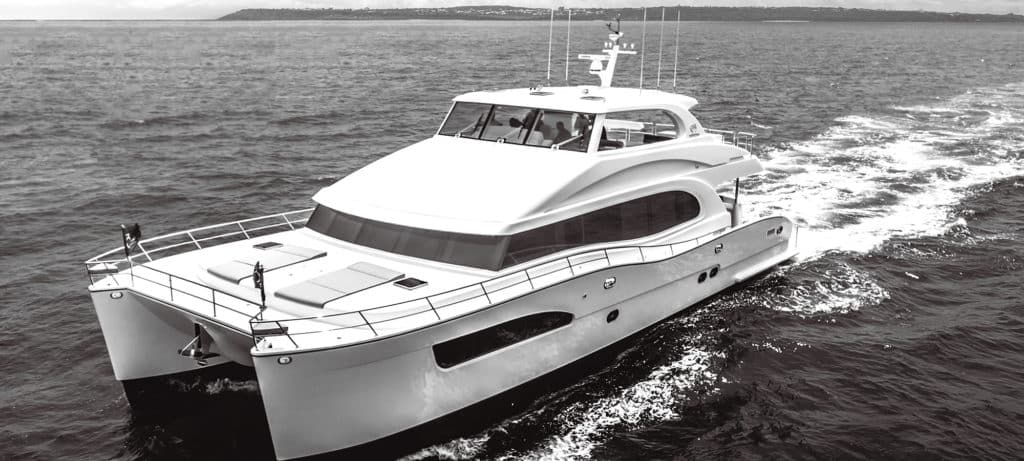
As founder and director of The Powercat Company, a Horizon Power Catamarans distributor, Stuart Hegerstrom had long believed that catamaran builders needed to design their yachts to more stylish standards.
“The boats were very boxy,” he says, based on his years of experience with cats in the charter market. He and his partner, Richard Ford, asked Horizon to produce models that had high-end finishes and looked good inside and out.
The Horizon team brought in mega-yacht designer JC Espinosa to work with its own craftsmen. The result aboard the Horizon PC74 is a catamaran with exterior styling, layout and functionality that should appeal to private and charter owners alike.
Read more: Horizon PC74
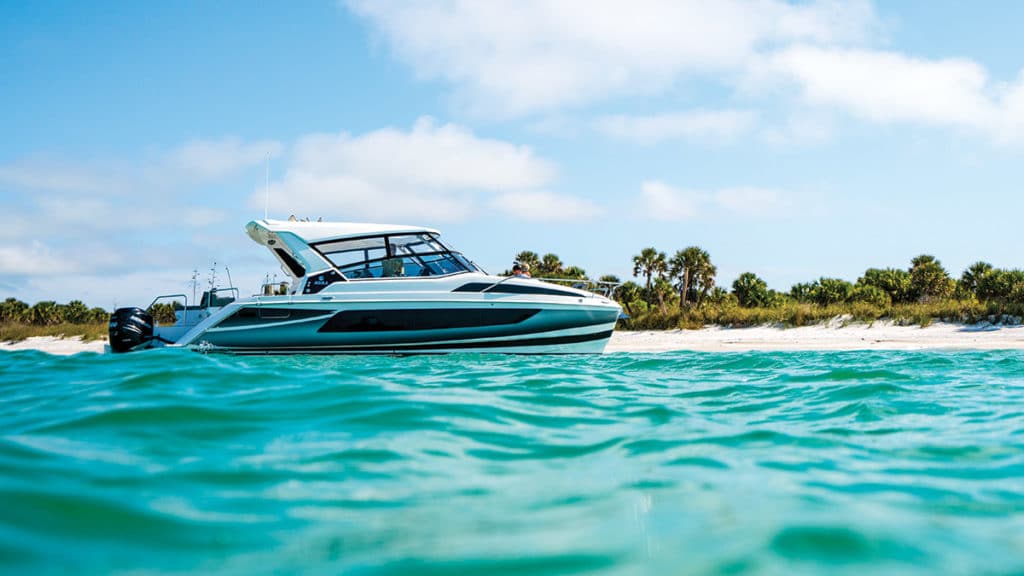
The Aquila 36 is a departure from her sisterships in that she is an outboard-powered, express-cruiser-style catamaran, but she also adheres to MarineMax’s philosophies.
With a single main living level from bow to stern and a beam of 14 feet 7 inches, the Aquila 36 is like a bowrider on steroids. She has seating that can handle 20 adults for outings and barbecues, and there are two staterooms below, one in each hull, for family weekending. The staterooms have nearly queen-size berths, en suite heads, stowage and 6-foot-6-inch headroom.
Read more: Aquila 36
Lagoon Seventy 8 Powercat
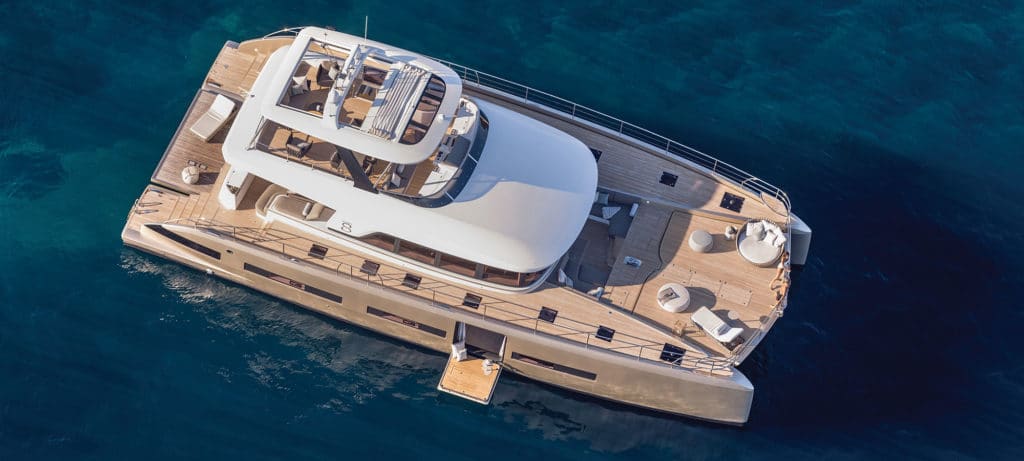
Lagoon is a division of Groupe Beneteau, the world’s largest builder of sailing yachts, and the Lagoon Seventy 8 Powercat is a developmental sistership of its Seventy 7 super sailing cat. The Seventy series yachts are built at Construction Navale Bordeaux in France, which had to add a new yard to construct these catamarans because they require separate stern molds for the power and sail versions.
Read more: Lagoon Seventy 8 Powercat
Horizon PC60
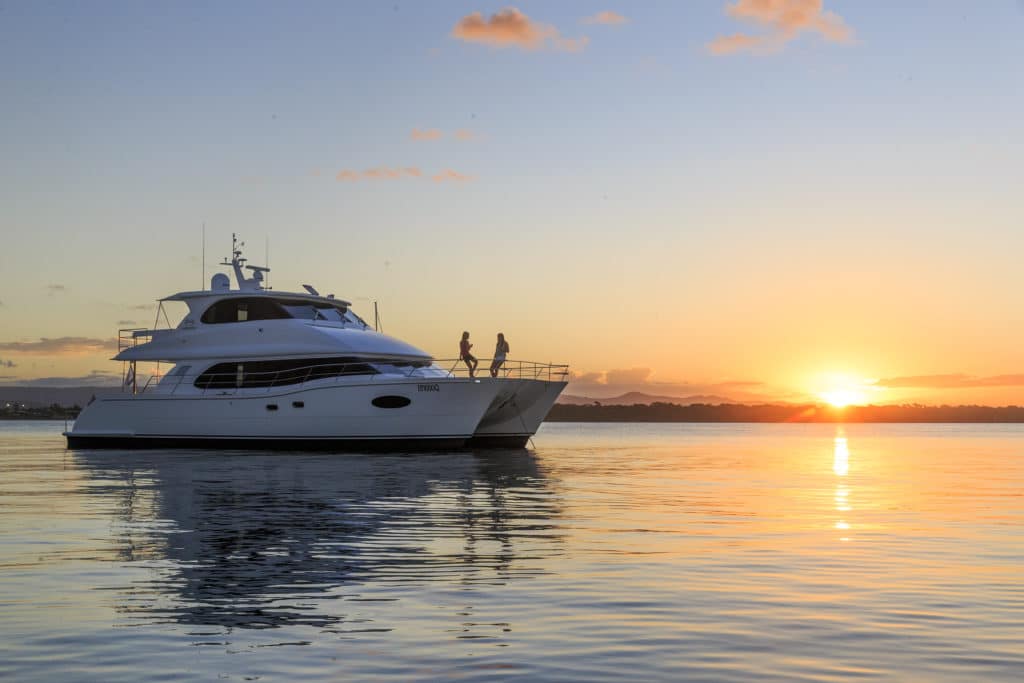
To understand the Horizon PC60 power catamaran , you need to put aside preconceived notions about midsize yacht amenities. For example, main-deck master suites are the province of yachts over 100 feet length overall. Incorrect. This 60-footer has an elegant and spacious owner’s stateroom on the same level as the salon. If you want a 14-foot center console tender on a 60-foot yacht, you have to tow it. Wrong again. On the PC60, you hoist it onto the upper deck, no problem.
Read more: Horizon PC60
40 Open Sunreef Power
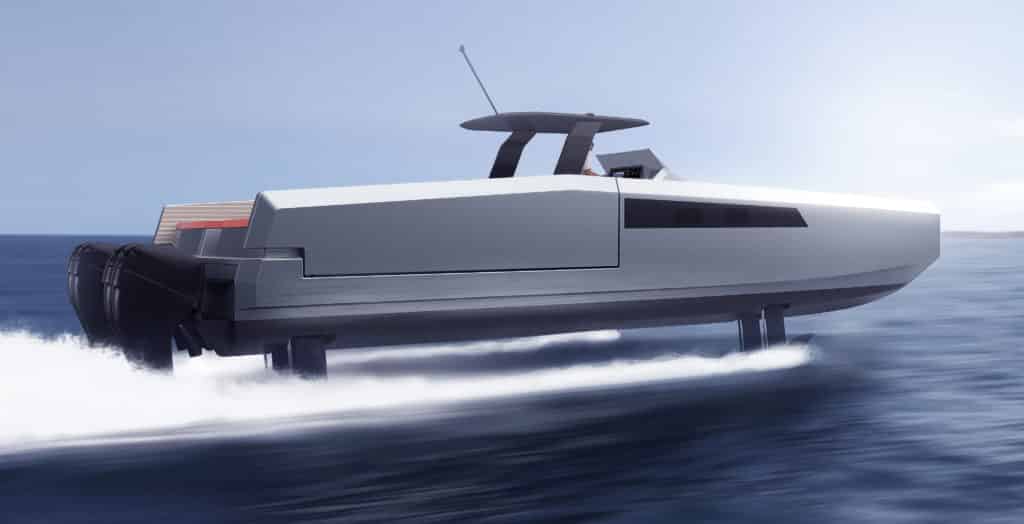
Sunreef is known for pushing the boundaries of catamaran design, incorporating four adjustable hydrofoils into a twin-hulled speedboat.
The Polish builder is one of several European builders (including Evo, Fjord, Wider and Wally) transforming the open day-boat category with creative designs. Beyond its hydrofoils, the 40 Open Sunreef Power ‘s cockpit has side “wings” along the aft gunwales that fold out at anchor, widening the beam from 17 feet to 22 feet 9 inches.
Read more: 40 Open Sunreef Power
Sunreef 50 Amber Limited Edition
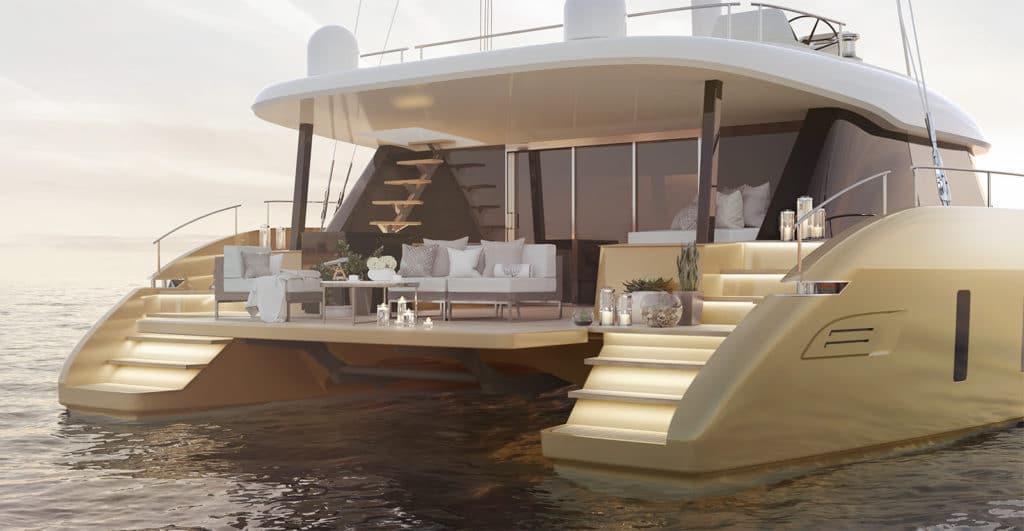
Sunreef Yachts introduced its 50 Amber Limited Edition , with plans to launch just 10 hulls of the exclusive design.
The Sunreef 50 Amber Limited Edition will have a carbon fiber mast and boom, four layout options and numerous amber-colored elements, including the hull.
Read more: Sunreef 50 Amber Limited Edition
Lagoon 630 Motor Yacht
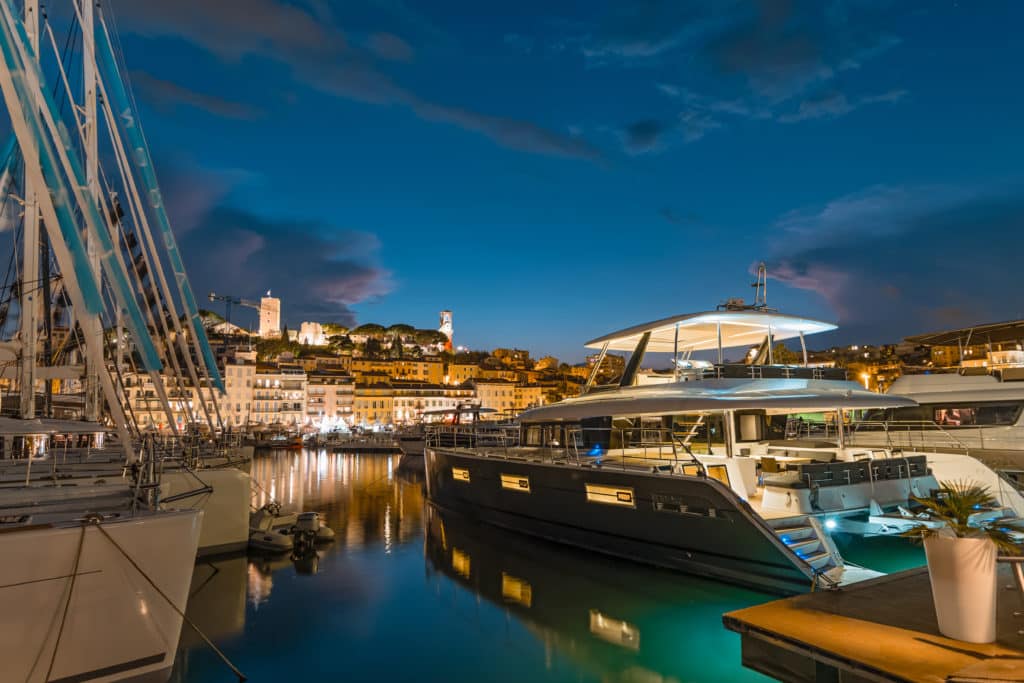
Fitted with the optional twin 300-horsepower Volvo Penta D4 diesels, the Lagoon 630 MY burns only 1.64 gph total at 6 knots, giving a theoretical range of 2,952 nautical miles with standard tankage of 793 gallons. Hull No. 1 had an optional 502-gallon tank, giving it transatlantic range.
Luxury, stability and economy are all hallmarks of Lagoon’s return to luxury motor yachts. If you can take a ride, it will be worth your time.
Read more: Lagoon 630 Motor Yacht
Fountaine Pajot MY 37
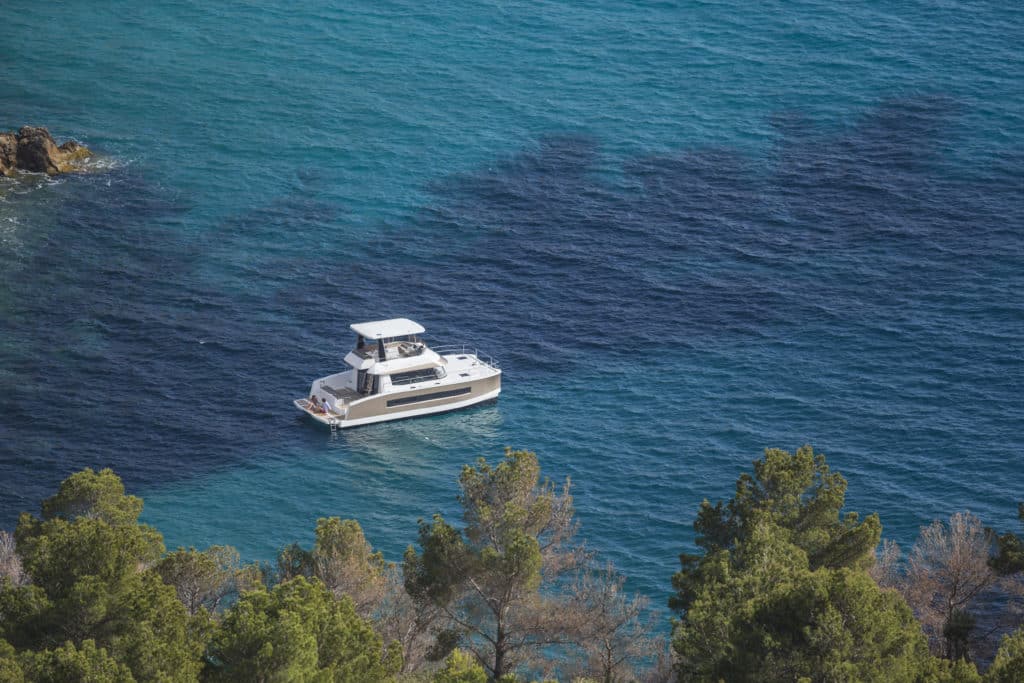
The Fountaine Pajot MY 37 easily accommodates the seafaring family with three- and four-stateroom options. In the three-cabin version, called Maestro, you’ll find an owner’s suite in the portside hull with a queen-size berth and en suite head. Two double-berth cabins and one more head are available for the kids. If your brood is bigger, the Quator setup features four double cabins with two heads.
The 37 is a traveler and can be powered with twin 150 hp or 220 hp Volvo Penta diesels. Top speed with the smaller engines is 17 knots, while it’s 20 knots with the bigger power plants. Interestingly, at 7 knots, the fuel consumption is the same, with either set of motors offering voyagers a 1 ,000-nm range.
Read more: Fountaine Pajot MY 37
Solarwave 64
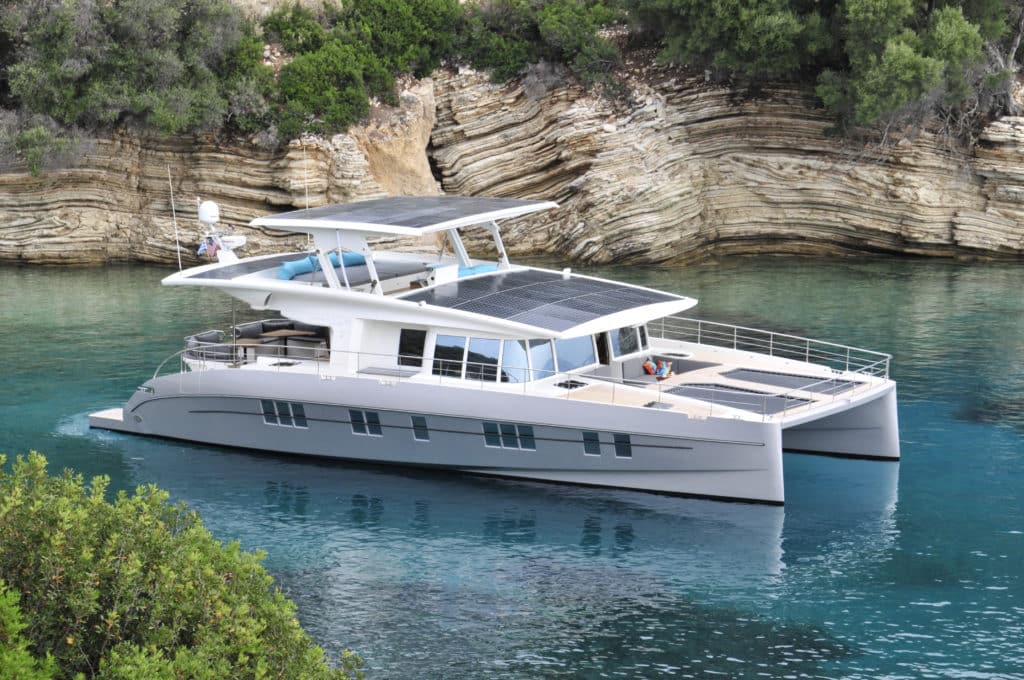
Many yachts boast eco chops because they have a handful of solar panels that power the microwave or navigation lights. The Solarwave 64 , launched last summer, has the potential to run on sunshine alone. The vessel’s 42 solar panels generate 15 kW that are stored in batteries weighing about 1,300 pounds. They connect to electric motors.
Read more: Solarwave 64
Glider SS18
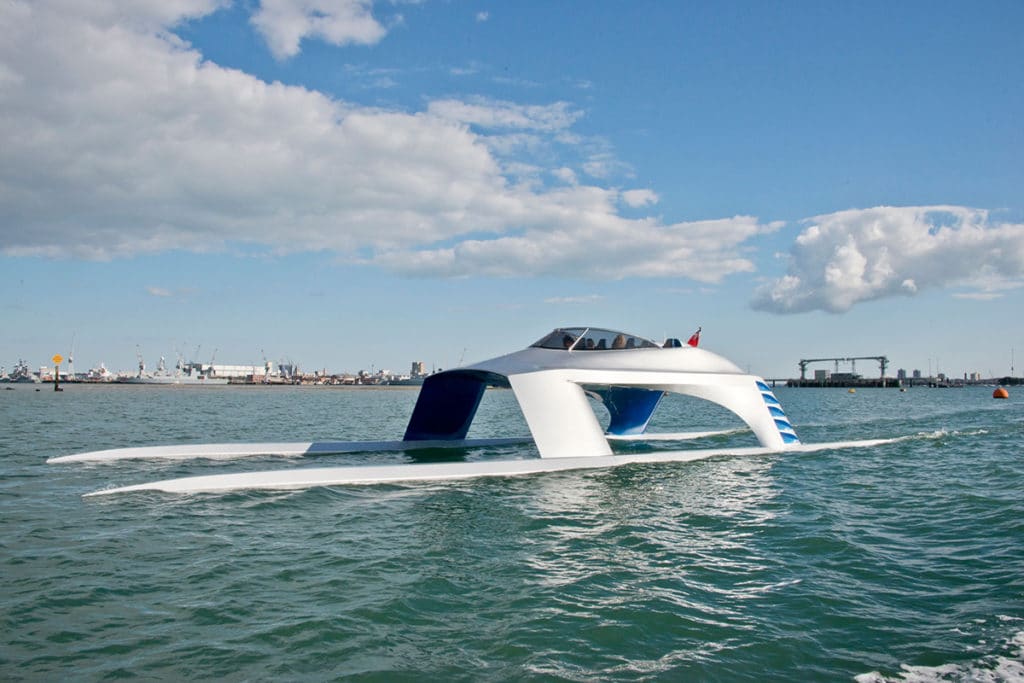
This British builder says it strives for design innovation and the Glider SS18 displays that DNA, the result of 8 years of research and development. She has a head-turning, catamaran hull form constructed from aluminum and composite materials. She is 60 feet LOA with a 17-foot beam, and has a relatively shallow 1-foot draft. Powered by quad Yamaha 300 hp outboards, she can reportedly reach 50 knots, and with her Stability Control System (SCS), should give a smooth ride while doing it.
Read more: Glider SS18
- More: aquila , Aquila Boats , Express and Flybridge Cruisers , Fountain Pajot , Glider Yachts , Horizon Power Catamarans , Lagoon , Power Catamarans , Silent-Yachts , Sunreef , Yachts
- More Yachts
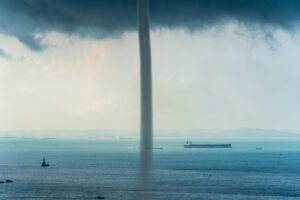
Superyacht Collision, Sinking Incident, Takeaways and Lessons
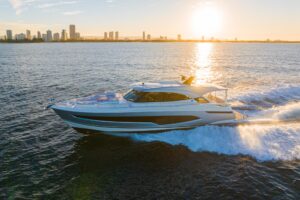
Riviera to Unveil 6800 Sport Yacht at Fort Lauderdale International Boat Show
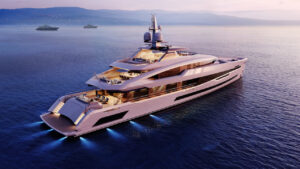
Heesen Reveals “Santosha” Details
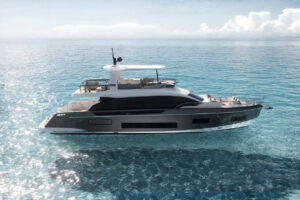
Azimut Launches the Fly 62
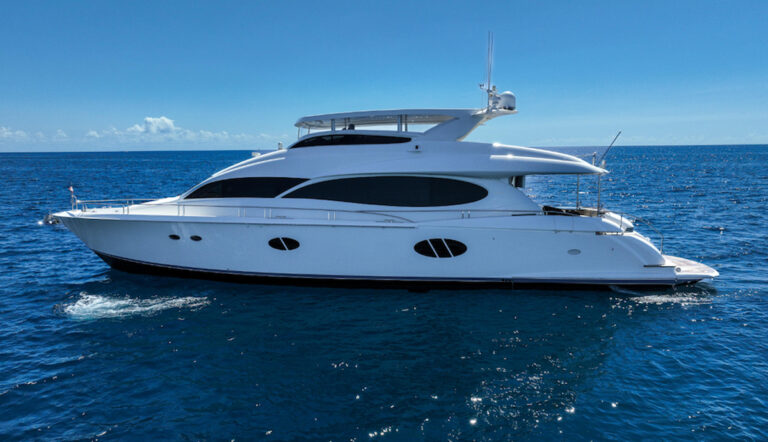
For Sale: 2006 84′ Lazzara
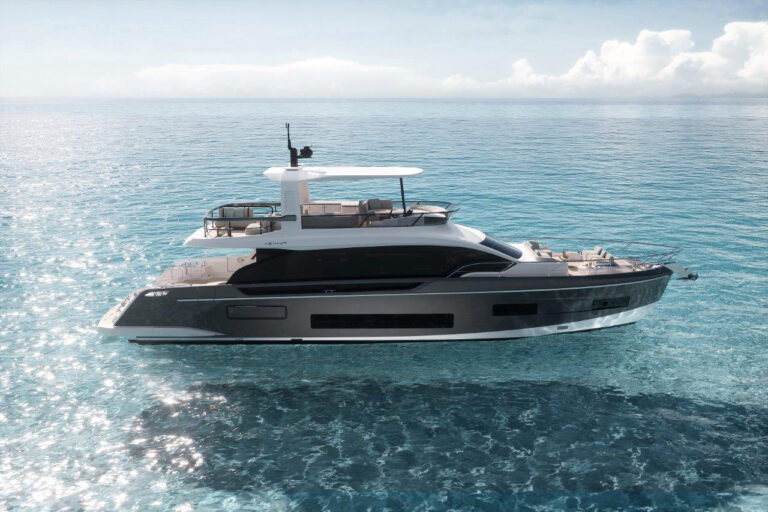
For Sale: 2015 Beneteau Swift Trawler 50
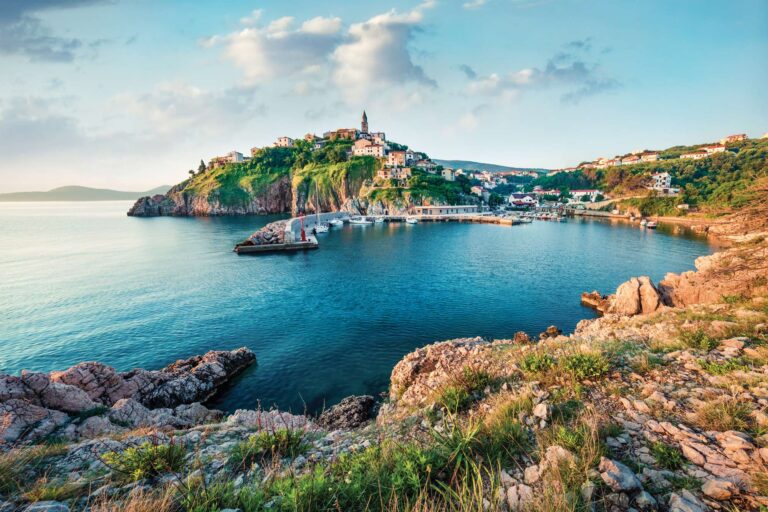
New Mediterranean Charter Options

- Digital Edition
- Customer Service
- Privacy Policy
- Terms of Use
- Email Newsletters
- Cruising World
- Sailing World
- Salt Water Sportsman
- Sport Fishing
- Wakeboarding

DIY Cruising Catamaran: Complete Building Guide
As an Amazon Associate, we earn from qualifying purchases. We may also earn commissions if you purchase products from other retailers after clicking on a link from our site.
A brand-new cruising catamaran can set you back a hefty amount of money. However, a DIY cruising catamaran provides a more affordable way to own your own boat. While building a large boat can be an extremely challenging and time-consuming experience, nothing beats the pleasure of bringing your own boat to life.
To build a DIY cruising catamaran, buy good design plans, determine your budget and find a working space. Next, choose your hull material, buy supplies and start building the mast beam. Build and sheathe the hull, install bulkheads, the interior, and finally, launch the catamaran boat.
In this article, you will find a complete guide to building your own catamaran. You will also find detailed information on why you may want to consider building your catamaran and approximately how much this project would cost. Finally, we will explore the advantages and disadvantages of building a catamaran from scratch.
Why You Might Want To Build Your Own Catamaran
Most people might think that purchasing a used boat to repair and fix it up would be cheaper than a DIY cruising catamaran. But while building your own catamaran could be an enormous undertaking, it also comes with many advantages over buying something used.
Other than the unique opportunity to create beautiful memories and experiences while cruising, sailing, and exploring beautiful coastlines, there are a number of benefits that come along with the DIY approach.
Knowing Your Boat
Building your own catamaran provides you with intimate knowledge of your boat. You will know every corner, including where to find every bolt, wire, bulkhead, rib, hose, and support as you installed them yourself. This knowledge will enhance your confidence while at sea since you will have entrusted your life to a boat whose history you are aware of and deeply connected to.
Pride of Ownership
The satisfaction you get from crafting something with your own hands is immense. As a result, the knowledge that you built your boat from scratch will fill you with absolute pride and an immense sense of achievement. Furthermore, as an owner-builder, you get to keep and enjoy the boat for as many years as you wish.
Substantial Cost Savings
Building your catamaran will work out cheaper than buying a new or even gently used boat. Though you will likely require some additional labor since doing some things will require an extra pair of hands, if you are particularly good at DIY, you will save a significant amount of money on labor costs as a whole.
Freedom To Create Your Own Designs
If you decide to buy a catamaran boat, it might not be easy to find one that meets your unique needs. However, instead of choosing from production boats that bear traditional and outdated designs, you can come up with an ultra-modern design or style for your catamaran. You also get to pick your layout, size, and equipment based on your taste and budget.
Great Learning Experience
Building your own boat will help you pick up numerous skills that will come in handy later when sailing your boat. As much as you might still require an expert to help you with specialized skills like carpentry or wiring, your new skills will serve you well. This will also be beneficial when it comes to your boat’s maintenance and fixing things for yourself.
What To Look For in Catamaran Boat Designs
When deciding on the type of catamaran boat to build, you may want to choose a design that’s simple and easy to build. This is because doing so will allow you to spend a shorter time building the boat.
You also need to have a set of requirements to guide you in choosing your design or what you might call an ideal cruising catamaran wish list. This is essential because, ultimately, you want to build a boat that offers outstanding qualities such as:
- Delivers good speed
- Affordable to own and operate
- Agile, strong, and easy to maintain
- Has a high resistance to capsizing
- Great for sailing and cruising
- Delivers a comfortable and easy motion underway
- Good handling ability and high performance under sail
- User-friendly embarking and disembarking
- Provides ample living and accommodation space
- Presents a reasonable resale value
It’s worth noting that, in general, catamaran boats tend to offer a fair resale value mainly because of scarcity and the high price accorded to production models. So, if you build a well-constructed catamaran, you are bound to get a return that’s much higher than the cost of materials upon resale.
It’s also good to consider whether the design you settle on is from an established designer. This is significant because documentation of the building process is just as valuable when it comes to selling the boat.
How Much Would It Cost To Build Your Own Catamaran?
The cost of building your cruising catamaran will depend heavily on the size of the boat you plan to build and the skills you bring to the table. To give you an idea of probable costs, a professionally built 40 foot (12.1 m) long cruising catamaran could go for up to $300,000.
Though building it yourself will undoubtedly be cheaper, most DIY boatbuilders tend to underestimate the expected costs. Your final costs should cover not only the cost of material and equipment but also the labor and time it would take to come up with the final product.
If you were to build a 40-foot (12.1-meter) catamaran, your cost of materials would range between 20-30% of the total cost. Therefore, for $300,000 total, the boat’s materials would range between $60,000 and $90,000. The hull tends to range between 15-35% of the total build. Again, this depends on the finish and furniture.
But before you even start working on the DIY project, you will need to figure out where to do the work. If your home has ample space, then you can opt for a backyard building. But if you live in a small apartment, then you might want to consider renting a small garage at first and then move on to a boatyard later. This is one of the significant costs involved in building your multi-haul.
What You Will Need
To get a clearer picture of how much the entire project would cost, let’s have a look at what else you will need to purchase.
- Good design plans
- Working space
- Ground tackle
- Matting and roving
- Equipment such as the engine, windows, rudders, deck fittings, mast, and rigging
In addition to the above, you also need to install plumbing and electricals. You may also want to consider going electric rather than using diesel. Not only will this drastically reduce your maintenance costs, but you get to use the regenerated power for all of your housing needs while sailing.
Some catamaran boat designs help you save costs by advocating the use of less expensive corpus materials. Most of the material goes directly into making the boat, which means there is hardly any wastage on vacuum bagging . With this method, there are few molds and temporal building forms and fewer fillers to grind off as waste. All these factors reduce the time and cost it takes to build your catamaran boat.
That said, building a boat of any kind is a huge financial undertaking. As such, you still need to have the financial ability to keep building; otherwise, your project will stall or take much longer than anticipated. Instead of enjoying yourself and making memories cruising to faraway lands, you might end up spending all your time building a seemingly never-ending boat.
To reiterate, this project is more of a labor of love, given that it involves a tremendous amount of manual work. Calculating an hourly rate on the time spent building the boat and adding this cost to that of materials may make it seem a very pricey exercise. However, it is vital to understand that your time matters, and every hour you spend working for “free” should be included.
With that in mind, you need to ensure that you are fully devoted to the boat construction project and are sure you want to do it before you begin. Stopping halfway because it seems like too much work would be incredibly costly.
How To Build a Catamaran
When it comes to building a cruising catamaran, you have 3 main options:
- You can buy an old boat and refurbish it.
- Purchase a bare hull plus deck molding for a home-boat building.
- Start from scratch and build everything, including the hull, on your own.
As mentioned above, renovating an existing boat may end up being more costly than starting from scratch. To build a catamaran boat from scratch, follow the below step-by-step guide.
Prepare the Essentials
Before you jump into such a large project, there are several important aspects to consider:
- Buy your plans from an established catamaran designer. You can also get inexpensive, easy-to-build catamaran designs online.
- Get access to a large working space or build a shed . Depending on your climate, you may need to opt for climate control to avoid an excess of moisture in humid areas.
- Decide on your choice of hull material. This could be fiberglass, aluminum, steel, wood, or ferroconcrete.
- Start working on a bill of materials estimate. Include everything that you think you need to get a better idea of the initial costs.
Build the Mast Beam
Using wood and epoxy, cut and glue together the pieces of wood that will form the mast beam. Most of the work at this stage can occur in a garage since it involves building small parts. Still, the work could take up to 4 months, so be prepared to put in long hours.
Build the Boat Hull
Now, it’s time to build the boat’s hull. A catamaran comprises two hulls which are connected with a deck. Below is a short video showing how to build a hull mold:
This work requires a larger facility, so you might need to move out of the garage and into a boatyard. If you don’t have access to a larger workshop, consider building a shed where you can work as you do the construction. Make sure there’s enough room to fit the boat and also allow you to work comfortably. To cover the shed, you can use opaque white tarps.
Sheathe the Hull
Get all the materials you require for this stage in the construction, such as lots of resin, fiberglass, and foam for use in the hull cores. You’ll also require matting and glass roving to sheath the hull .
Sheathing helps to make the hull impervious to water and other marine borers. But first, you need to prepare the hull using a rotary sander. To make it as smooth as possible, use light, sweeping strokes. This is a very dusty task so be prepared to wear a facemask and safety goggles.
Install the Bulkheads
Next is installing the plywood bulkheads . You might need to call in friends to help turn the hulls or use a crane. In this step, you will need to laminate the hull sides on the molded hull panels and bond them above the bulkheads. Ensure the bulkheads are snug and sealed in place.
Construct the Interior Structure
Over the next couple of months, the boat work will involve joining the hulls together with the beams that you had made back in the garage. Then, install the cuddy cabin, decks , and the cockpit . Soon the boat will start to take the shape of a catamaran.
Next, proceed to construct the major structural components such as stairs, hatches, mini-keels, and the interior. Then comes the work of fairing the boat, which is quite labor-intensive.
Finally, it’s time to apply primer on the catamaran boat and start the paintwork. Before painting the boat, you will need to do additional sanding to finish off the two layers of primer as well as fill all the pinholes. Since it’s a large boat, the catamaran has lots of surface area; thus, the sanding could get extremely exhausting—mentally and physically—at this point.
The painting can take a while, too. The hulls are the easiest to paint, but the topsides, non-skid, as well as masking and prepping could seem never-ending.
The final stretch involves working on the center bridge deck cabin and other final touches like installing the engines, electricals, and plumbing. This is also the time to fix the rudders, rigging, mast, windows, and deck fittings.
Launch Your Cruising Catamaran
After many months or years of hard work, your cruising catamaran is finally ready to test the waters. After lowering the boat into the water, check carefully in case there are leaks. If none, you can set up the sails and take your catamaran out for your first cruise.
Below is a short video that takes you through the entire boat-building process:
If you don’t have deep pockets, don’t despair. It’s also possible to build an inexpensive catamaran boat, as shown in this post from the coastal passage .
The Pros of Building a Catamaran
Though it will be a costly endeavor, there are so many things to look forward to should you decide to build your own catamaran:
- It can be lots of fun.
- You get to have a new boat.
- It’s an excellent hobby for DIY enthusiasts.
- The effort is rewarding.
- It offers a great learning experience.
- You get the exact kind of boat you want.
- You can alter building plans and tailor the boat to suit your specific needs.
- It might be cheaper than buying a new boat.
The Cons of Building a Catamaran
Though there are a number of positive aspects to a DIY build, it is just as important to keep in mind that it won’t always be easy:
- Maintenance costs can be quite high.
- It’s both mentally and physically exhausting.
- It might require some technical know-how.
- It can take many months or even years to complete.
- It requires a lot of commitment to finish the DIY project.
- It might be challenging as well as expensive to get insurance.
- You will spend almost all your free time building the boat.
DIY Cruising Catamaran Tips and Tricks
If you are new to boat building, it would be a good idea to build a small boat first. This would give you a good indication as to whether you’d enjoy tackling a more extensive project like building a catamaran. Again, if you are the handy type, fixing your own electronics could also save you a significant amount of money.
Here are more tips and tricks to get the most out of your DIY cruising catamaran:
- Lower your costs. Bring down your costs even further by sourcing for parts and supplies at marine surplus outlets, Craigslist, eBay, or wholesale suppliers.
- Enhance your resale value. Most home-built boats are not easy to sell since they tend to be too customized. To enhance your resale value, it’s advisable to work with a standard design from a well-established naval architect.
- Follow the design instructions. Make sure to follow the designer’s instructions regarding the type of materials and tools to use during the build to avoid making costly mistakes.
- Maintain your original budget. Avoid any additional customizations once you have started building the boat. Using good plans and sticking to them ensures that your budget doesn’t spiral out of control.
Final Thoughts
Building a catamaran is about more than saving money. It’s fun, exciting, fulfilling, and can be a great learning experience. While it might take many months of back-breaking work, comparative shopping and sourcing for materials will help you save a lot of money. Still, at the end of it all, you’ll have a beautiful catamaran boat, all ready for your first cruising adventure.
However, if you have neither the time nor the energy to build your own catamaran from scratch, refurbishing an existing hull might prove faster and easier. It also works out much cheaper than buying a new boat.
Owner of CatamaranFreedom.com. A minimalist that has lived in a caravan in Sweden, 35ft Monohull in the Bahamas, and right now in his self-built Van. He just started the next adventure, to circumnavigate the world on a Catamaran!
One thought on “ DIY Cruising Catamaran: Complete Building Guide ”
Hello, I am a French Quebecer who is original, imaginative, creative and who finds that all boats and catamarans have a huge flaw and a very big lack of logic. I would have a brand new concept…. I am sending this message to any catamaran creator – designer to make those who have the opportunity and the intelligence to want to know about my innovative idea which will finally upset the market much richer. An idea that will totally change the concept of sailing, navigation and save so much worry!! All I would ask for is a small percentage of each sale of the new product. To be able to make me produce one when I have enough!! It is certain that like that, you just want to tell me: come on Mr. Lessard give us your idea but do not take your word to help me in return! But, if you are the kind of man to have only one word and maybe have a proof of your good faith if the realization of the project would make it… I will be very happy!! Giving it to everyone wouldn’t bother me either…. all I would like is to be able to find flax fiber (too expensive carbon) to be able to try to make my catamaran myself. Because not rich! Have a nice day and looking forward to having a message!!
Leave a Reply Cancel reply
Your email address will not be published. Required fields are marked *
Save my name and email in this browser for the next time I comment.
Recent Posts
Must-Have Boat Gear for Catamaran Sailors!
Sailing is probably the most gear-intensive activity I've ever done; there are so many decisions to be made about what gear to buy now, for tomorrow, and what to definitely never buy. The gear on...
6 Best Trailerable Trimarans For Bluewater and Coastal Sailing
Having a boat costs a lot of money, even when you are not using it, marina fees, etc. And once it is in the water most sailors never go very far from their "home marina" and sailing will be somewhat...
COMMENTS
Find various power catamaran plans and kits for aluminum and fiberglass boat building methods. See photos, details and prices of different models and custom designs.
ECO 55 Power Cat Plans. The ECO 55 power catamaran is an affordable DIY power catamaran. As the owner proved the boat is a capable coastal cruiser. The inside layout is the same as for the ECO55 sail version but the underwater shape is changed. The cockpit is wider and has a size of 1,45m x 2 m. With the bigger size normal deck chairs can be used.
Kurt Hughes Multihull Design - Catamarans and Trimarans for Cruising and Charter. Order the Latest Design Portfolio today to see over 85 multihull plans in stock. Besides illustrating my stock designs, for which I sell study plans and full construction plans, it also contains my design philosophy of multihulls; an article on the rapid Cylinder ...
The ECO 75 power cat is the big brother of the ECO power cat. Designed along the same lines and with the same philosophy. Easy to build boat by an amateur. Construction is the time proven plywood/glass fiber/Epoxy composite system. Nothing can match this system for weight, costs and easy of construction. Besides this advantages no maintenance ...
Power Catamarans: A Complete Guide. Dec 06, 2023. less than a min. Power Catamarans, often termed as the epitome of modern maritime engineering, are gaining popularity for all the right reasons. Their distinct design, enhanced stability, and cruising efficiency set them apart from traditional monohull boats and even their sail-driven counterparts.
Catamaran Stock Plans Ed Horstman designed TRIMARAN and CATAMARAN plans are drawn for the first time builder. Plans are concise and clearly drawn so the builder can easily follow each building step. Designs are continuously updated with your input and new ideas. Plans include full size patterns to 63'.
New Power Catamaran Boat Designs. Stock plans & custom designed to suit your needs.
Roberts Power Catamaran 39. These catamarans were designed to be built using the fibreglass panel construction techniques. The method is very simple to use and very good for the inexperienced builder. Full size patterns are supplied for the female frame formers therefore there is no lofting required. Special pre-scaled drawings are supplied for ...
Roberts Power Catamaran 46. These catamarans, the Cat 39 and Cat 46, were designed to be built using the fibreglass panel construction techniques. The method is very simple to use and very good for the inexperienced builder. Full size patterns are supplied for the female frame formers saving you lofting time and expertise.
Catamarans and Trimarans Catamaran and Trimaran Boat Plans make it a reality to build your own catamaran or trimaran. Multi-hulled sailing vessels are a special class of boat. A very different mind set is required when thinking about sailing a multi hull, let alone getting your head around building one.
CATEGORY: Power Catamarans CONSTRUCTION: Sheet plywood/wood framing, or welded aluminum These longer, wider power cats allow greater displacement, tankage, storage, and load-carrying ability than our WILDCAT design. Besides the extra room, the wider beam only improves upon the superior qualities of power cats, especially stability.
We build a power catamaran in a few different models, pilothouse, center console, and a commercial version.
A word about power catamarans The HELL CAT features a very large cockpit with plenty of room to haul diving gear, passengers, etc. As with all the cats, the optimum word is comfort with the space to spread out, and a ride that cannot be compared to any other type of boat you may have ridden in. The tough structure, proven in prototype testing, is built to take it. Using our complete Plans and ...
POWER CATAMARAN PLANS and KITS, CATAMARAN PLANS , Bruce Roberts WEB SITE offers catamaran boat plans and catamaran boat kits for fiberglasss and aluminum boat designs, cut to size CATAMARAN kits, part built boats or complete boats. Bruce Roberts Yacht Designs offer boat building project management arrangements for boats built overseas at affordable prices. Sailboat and Powerboat building plans ...
The Skoota 18 is a simple to build and trail power catamaran. It is based on the Chat 18 sailing catamaran but with extra buoyancy aft to take a bigger engine, up to 20hp. This gives an economic cruising speed around 9-10 knots and top speed in the low teens. The small cuddy offers protection during the day while the boom tent and long cockpit seats mean you can camp on board for a night afloat
Mike Waller Yacht Design provides comprehensive boat plans for amateur boat builders. A range of stock plans are available for both monohulls and multihull vessels, constructed in plywood or timber / glass composite.
We design modern high performance sailing catamarans, trimarans and power cats. Contact us to find the right professionals and resources for your project, or to create a custom design to empower your vision for time on the water.
Bloomfield Innovation supply naval architect and engineering design services for composite and aluminium catamarans from 6m (20') up to 60m (200'). Our range includes trawler catamarans, power catamaran yachts and racing and cruising sailing catamaran designs. All designs may be constructed to survey or classification society rules using ...
What are Power Catamarans Power catamarans are boats with two hulls which are powered by motors as opposed to sails. (If you're interested in sailing catamarans, you can learn all about them in Sailing Catamarans: A Comprehensive Guide ).
Power Multihulls. These low-drag powerboats give a much better ride and require far less power than other types for target speeds of up to 2.5 to 3.0 times the vessel's hull speed. Excellent economy, a superior ride, and a more extensive cruising range are possible with these displacement multihulls. Some of those catamaran powerboats are ...
Here, we take a look at 12 catamarans ranging from a cruising-couple-size 36-footer to a 78-footer for friends, family and some more friends. And there are myriad power options: outboards, diesel inboards, hybrid or even all-solar power.
To build a DIY cruising catamaran, buy good design plans, determine your budget and find a working space. Next, choose your hull material, buy supplies and start building the mast beam. Build and sheathe the hull, install bulkheads, the interior, and finally, launch the catamaran boat.
SPIRITED 400 'Power'. The Spirited 400 'Power' is a semi-displacement power cat with sleek lines and light weight structure. For those who like 'turn-key' cruising this highly efficient design is always in readiness for a quick getaway. The slim hulls run easily through the water and provide a very comfortable ride even in rough conditions.